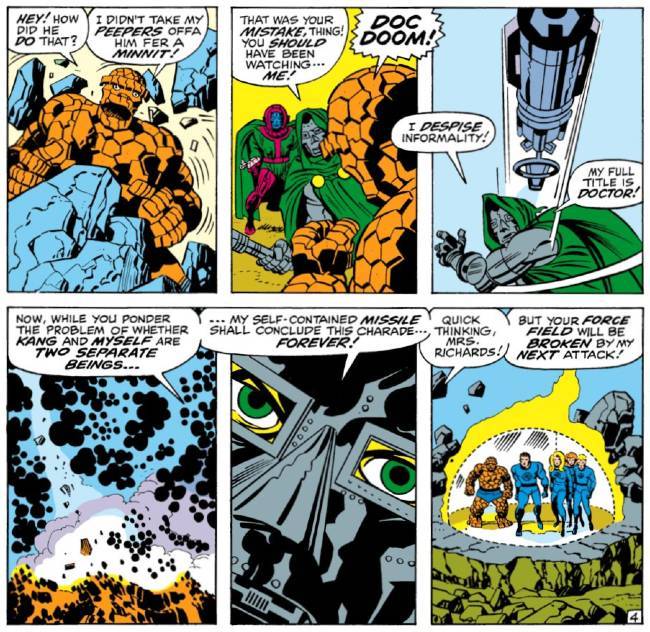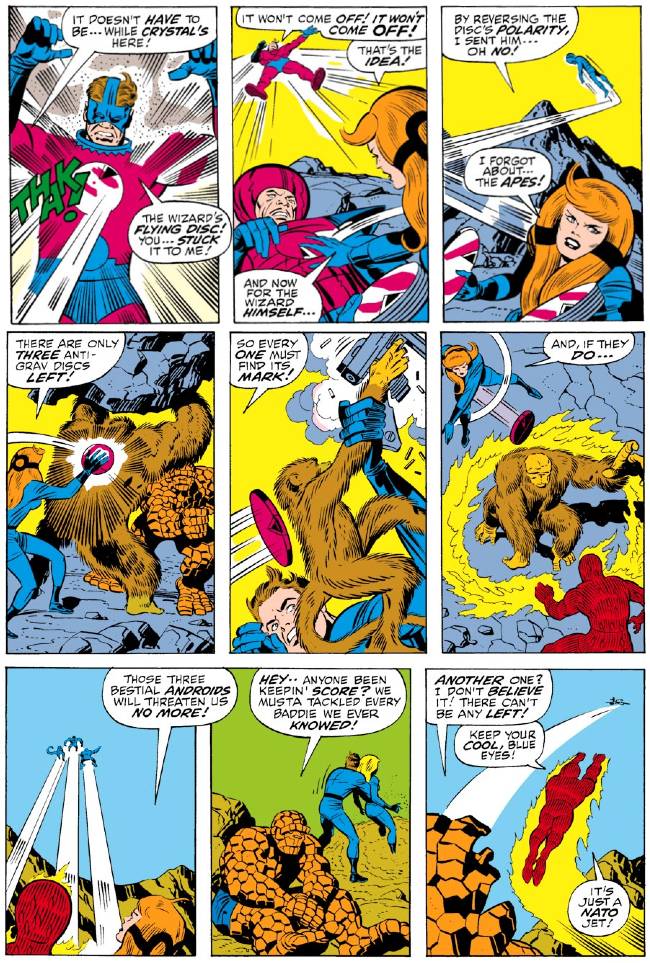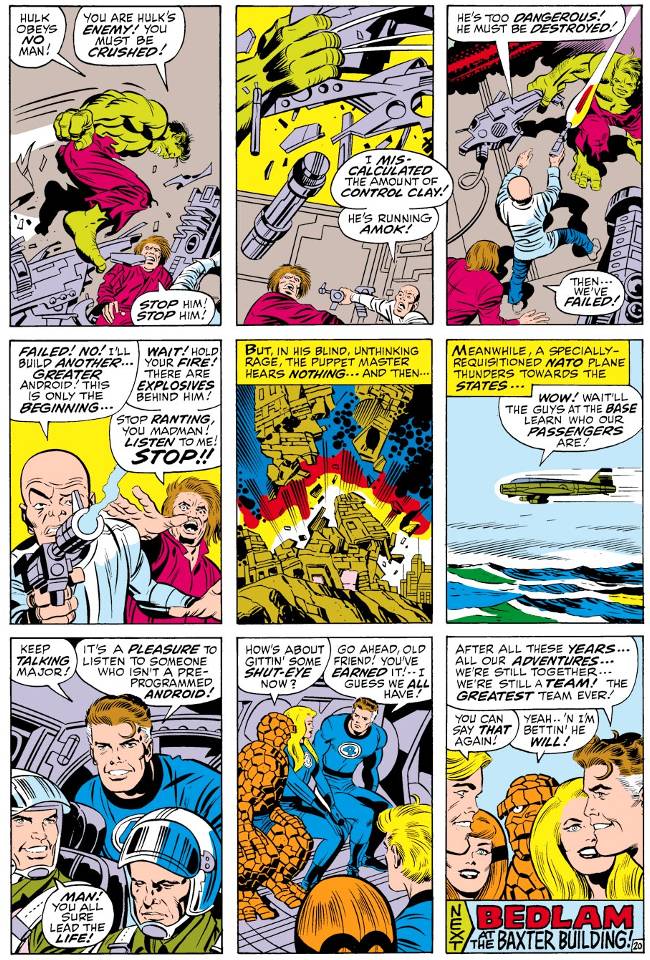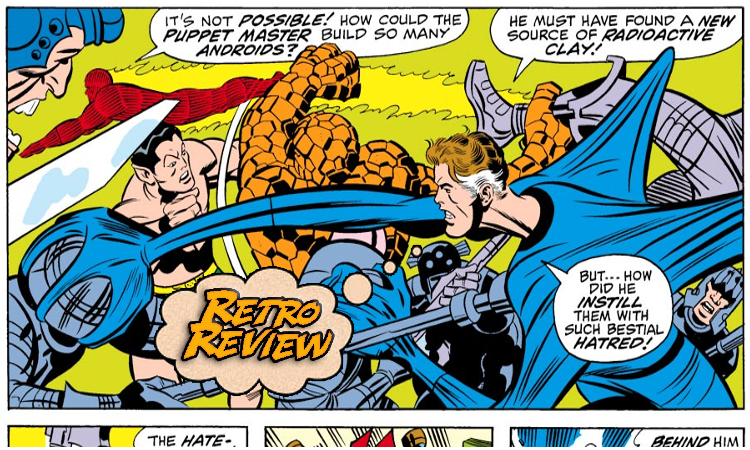Since their fateful test flight, Reed, Sue, Johnny, and Ben have faced a literal army of foes, from dragons to time-travelers to clones of deposed dictators. But what happens when ALL those foes return at once? Your Major Spoilers Retro Review of Fantastic Four #100 awaits!
 FANTASTIC FOUR #100
FANTASTIC FOUR #100
Writer: Stan Lee
Penciler: Jack Kirby
Inker: Joe Sinnott
Colorist: Uncredited
Letterer: Sam Rosen
Editor: Stan Lee
Publisher: Marvel Comics
Cover Price: 15 Cents
Current Near-Mint Pricing: $180.00
Release Date: April 17, 1970
Previously in Fantastic Four: A brilliant scientist, his best friend, the woman he loved, and her fiery-tempered kid brother! Together, they braved the unknown terrors of outer space, and were changed by cosmic rays into something more than merely human! They became the FANTASTIC FOUR!
After a visit to the city of Attilan, the homeland of their fifth member, princess of the Inhumans, Crystalia Amaquelin, the FF find their craft shot out of the skies somewhere over the Middle East!
 Thanks to Crystal’s power of the air, the non-flying members of the team are gently brought down to Earth, where The Human Torch reports that their ship has been smashed to bits, with no chance of repair. Before Mister Fantastic can take a crack at getting them back in the air, their attacker makes himself known: Kang the Conqueror! His future technology puts the team on their back foot, but before The Thing can retaliate, a massive boulder smashes across his rocky hide.
Thanks to Crystal’s power of the air, the non-flying members of the team are gently brought down to Earth, where The Human Torch reports that their ship has been smashed to bits, with no chance of repair. Before Mister Fantastic can take a crack at getting them back in the air, their attacker makes himself known: Kang the Conqueror! His future technology puts the team on their back foot, but before The Thing can retaliate, a massive boulder smashes across his rocky hide.
 The alliance of Kang and Doctor Doom (who, at this point, have been strongly hinted to be the same man existing at different points in the time-stream, hence Doom’s strange taunt) is a catastrophe, to be sure. But once again, it’s Crystal whose power makes the difference, uprooting a massive oak tree and literally throwing it at the masked malefactors. The villains are shocked at the attack, but the Fantastic Five barely have the time to register that those particular villains really shouldn’t have been vanquished by that attack. As Reed discovers that they’ve been attacked by androids, the REAL threat behind the attacks is monitoring the situation from afar.
The alliance of Kang and Doctor Doom (who, at this point, have been strongly hinted to be the same man existing at different points in the time-stream, hence Doom’s strange taunt) is a catastrophe, to be sure. But once again, it’s Crystal whose power makes the difference, uprooting a massive oak tree and literally throwing it at the masked malefactors. The villains are shocked at the attack, but the Fantastic Five barely have the time to register that those particular villains really shouldn’t have been vanquished by that attack. As Reed discovers that they’ve been attacked by androids, the REAL threat behind the attacks is monitoring the situation from afar.
 Fifty-odd years down the line, the art of Jack Kirby has somehow become an acquired taste among comic readers, but I can’t help but look at every panel of this book in awe. The detail in the lair of The Puppet Master and The Mad Thinker is pure comic brilliance. Most of this issue is actually done in a nine-panel grid (a reminder that Moore and Gibbons didn’t invent that technique with Watchmen), which allows the story to cover more territory and deliver more old foes than a series of splash pages ever could. The attacks continue, and while the combination of awesome androids and radioactive clay is able to replicate the bodies and the minds of Kree Sentry, Dragon Man, Sub-Mariner, and Hate-Monger, they cannot give their artificial foes the same level of power or versatility. The team defeats each of those foes in turn, thanks in large part to teamwork and, unexpectedly, the presence of Crystal, whose elemental powers wipe out Namor, Hate-Monger, and a battalion of Skrulls all at once. Then, when the Red Ghost AND the Frightful Four arrive, it’s Crystal who uses their own counterfeit flying discs against them to win the day.
Fifty-odd years down the line, the art of Jack Kirby has somehow become an acquired taste among comic readers, but I can’t help but look at every panel of this book in awe. The detail in the lair of The Puppet Master and The Mad Thinker is pure comic brilliance. Most of this issue is actually done in a nine-panel grid (a reminder that Moore and Gibbons didn’t invent that technique with Watchmen), which allows the story to cover more territory and deliver more old foes than a series of splash pages ever could. The attacks continue, and while the combination of awesome androids and radioactive clay is able to replicate the bodies and the minds of Kree Sentry, Dragon Man, Sub-Mariner, and Hate-Monger, they cannot give their artificial foes the same level of power or versatility. The team defeats each of those foes in turn, thanks in large part to teamwork and, unexpectedly, the presence of Crystal, whose elemental powers wipe out Namor, Hate-Monger, and a battalion of Skrulls all at once. Then, when the Red Ghost AND the Frightful Four arrive, it’s Crystal who uses their own counterfeit flying discs against them to win the day.
 Destroying two different faux-FFs at once is the trigger that convinces Puppet Master and Thinker to unleash their most potent project of all: The Incredible Hulk.
Destroying two different faux-FFs at once is the trigger that convinces Puppet Master and Thinker to unleash their most potent project of all: The Incredible Hulk.
“Go, Hulk,” Puppet Master commands, “Destroy the Fantastic Four!”
Remember how they were able to recreate the minds and emotions of their androids? That’s not something you want when you’re dealing with the Hulk.
 Destroyed by their own hubris without even facing their foes in person, the two insane geniuses remind us that the real strength of the Fantastic Four is in their teamwork, something that is embodied by Crystal’s role as MVP in this issue’s adventure. Rather than worry that The Thing or The Human Torch needs more individual time, Stan and Jack’s storytelling feels like it organically allows each member their place. Most importantly, this story feels like a major threat to the team while also being the equivalent of a sitcom clip show, showing us why Fantastic Four #100 is an example not only of the way that Marvel shook up the comic industry during the 1960s, it serves as a sort of capstone for the Lee/Kirby era, earning 4.5 out of 5 stars overall. Within a few issues, Jack would be at DC creating his Fourth World, with the Marvel Universe enduring the beginnings of ’70s doldrums and a series of short-lived Editors-In-Chief making for an inconsistent half-decade, but at least here, readers got The World’s Greatest Comics Magazine in action.
Destroyed by their own hubris without even facing their foes in person, the two insane geniuses remind us that the real strength of the Fantastic Four is in their teamwork, something that is embodied by Crystal’s role as MVP in this issue’s adventure. Rather than worry that The Thing or The Human Torch needs more individual time, Stan and Jack’s storytelling feels like it organically allows each member their place. Most importantly, this story feels like a major threat to the team while also being the equivalent of a sitcom clip show, showing us why Fantastic Four #100 is an example not only of the way that Marvel shook up the comic industry during the 1960s, it serves as a sort of capstone for the Lee/Kirby era, earning 4.5 out of 5 stars overall. Within a few issues, Jack would be at DC creating his Fourth World, with the Marvel Universe enduring the beginnings of ’70s doldrums and a series of short-lived Editors-In-Chief making for an inconsistent half-decade, but at least here, readers got The World’s Greatest Comics Magazine in action.
Dear Spoilerite,
At Major Spoilers, we strive to create original content that you find interesting and entertaining. Producing, writing, recording, editing, and researching requires significant resources. We pay writers, podcast hosts, and other staff members who work tirelessly to provide you with insights into the comic book, gaming, and pop culture industries. Help us keep MajorSpoilers.com strong. Become a Patron (and our superhero) today.
FANTASTIC FOUR #100
It's tough to balance the story when the premise is "fighting nearly all the people we fought in the previous 99 issues", but the Lee/Kirby team pull it off with aplomb, thanks to lively art and the dialogue that made the FF comics' most beloved super-family.
-
Writing9
-
Art9
-
Coloring9


